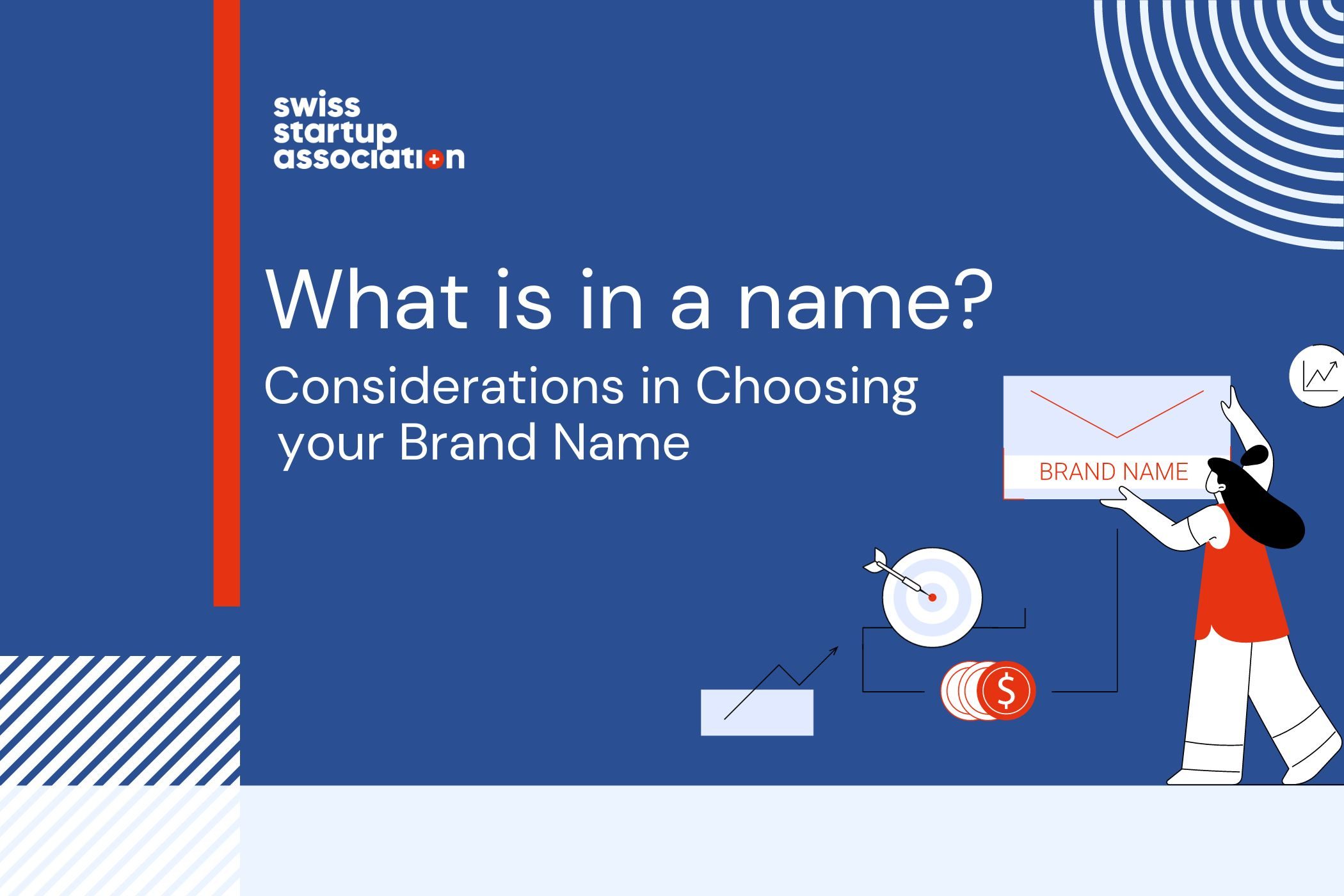
What is in a name? Considerations in Choosing your Brand Name
What’s in a name?
A rose by any other name would smell as sweet!
True – but if a rose was called a hellebore, you might not have ventured close enough to take a sniff.
Marketing is about making impressions; every touchpoint creates an impression of your business and what it offers. Your brand name should be contributing to positioning your business and facilitate building awareness.
The name itself can be evocative and help convey your brand’s identity. Think of characters like Darth Vader, Ernst Blofeld, Voldemort – you just know they are the bad guys….at least in my language. Things are a bit more complicated across languages and there are famous name failures: Clairol’s hair curling iron ‘Mist Stick’ and ‘Vicks’ cough drops didn’t work in Germany; Mercedes-Benz Chinese brand ‘Bensi’ meant “rush to die” and had to be changed.
Here in Switzerland? I asked Sandra Kobel, CEO & Co-founder at zealy, a Swiss Startup Association’s Marketing partner, for some words of advice:
Navigating the branding landscape in Switzerland is like orchestrating a symphony in four distinct languages. In this multilingual environment, opting for an English name seems a good strategy as a common ground that can reduce potential pitfalls in translation and unintentional linguistic missteps.
And a Swiss example, highlighting the importance of meticulous language testing and legal reviews. Coca-Cola’s 2018 Fuzetea launch required a different name in Switzerland, as the worldwide had undesirable connotations in Swiss German. This was identified in pre-launch focus groups; nevertheless amending a single letter to Fusetea in packaging, billboards and TV spots for one country added CHF1m to the launch costs.
DEFINING YOUR BRAND ARCHITECTURE
Startups can simply establish with a single brand/company name, however as soon as new products/services are developed, deciding on a brand architecture for the future becomes important.
Brand names are more important in B2C, however B2B companies shouldn’t neglect good branding principles in choosing a good name, building brand awareness and having a brand architecture for naming future offerings. (You can even embrace the principles in baby naming, where a US baby-name consultant offers a $30,000 package to find a name that fits your family’s personal brand!).
Back to the topic at hand, will you be a house of brands or a branded house? Or something in between?
A Branded House is most common, where names of products/services are sub-brands of the parent brand – like Apple, Nike, Google. These sub-brands are not independent and never overshadow the parent brand. There are obvious efficiencies in marketing and the ability to leverage the parent brand for future offerings.
A House of Brands has independent brands, each with their own audience, marketing and look & feel – like P&G, Unilever. This works for large companies with a broad product portfolio, offering freedom and flexibility to define each brand; also to buy and sell brands. The disadvantages are increased maintenance and management (= cost), and less overall brand power.
There’s also a Hybrid brand architecture, which perhaps provides the advantages of both worlds as the parent brand is used for some products (Coca-Cola, Toyota) and independent sub-brands exist for others (eg. Coca-Cola’s Minute Maid, Sprite, Schweppes etc).
In deciding the brand architecture, you should consider:
- Will you expand into multiple product lines or market segments?
- How many types of products/services will you have? Are they closely related?
- How do your competitors do it? And how will you compete?
Fundamentally, this is about how you are going to name your portfolio of products/services in the future, with the architecture facilitating future naming decisions to develop a coherent portfolio offering. Look at how other companies do this and what sort of naming approach could work for you.
zealy advises startups to consider potential line extensions right from the start. It’s like charting a course for a ship—you want a clear path ahead. Early planning not only helps establish a robust brand architecture but also provides a practical vision of how the brand will integrate into daily life, especially when introducing new products/services.
Sandra leans towards building a strong core brand rather than a house of brands. The efficiency gained from this focused approach is invaluable and makes resource management a more straightforward task. While a house of brands might work for conglomerates, startups often flourish by honing in on a specific message and identity.
Keeping things under one umbrella simplifies the storytelling and fosters a stronger connection with customers.
CREATING YOUR BRAND NAME
zealy suggest you consider brand creation as an art, explore various angles of meaning, fantasy and description. Your startup’s name should reflect its distinctiveness and, ideally, provide a glimpse into its essence. Think of it as a first impression—a teaser for your value proposition.
In generating name options, deploy a diverse range of creative approaches, as well as consider naming ‘rules’ from Marketing theory:
- Engaging and memorable
- Evoking a vision
- Distinctive
- Concise
- Appropriate
- Easy to spell and pronounce
- Stand the test of time.
And not forgetting those linguistic challenges – Sandra’s advice: When deciding your brand name, treat each language as a unique canvas. Be vigilant not only in avoiding unintended meanings but also in crafting a name that resonates across languages. A brand that transcends language barriers is unifying and inclusive in a nation of diverse voices.
Do you have to like the brand name?
zealy caution that while it is important for the founders to resonate with the chosen name, don’t forget the primary rule of the branding game: it is the fish that has to like eating the worm, not the fisherman. Strike a balance between personal preference and market appeal. And remember, it is the catchy and memorable tunes that linger longest in the mind.
Beyond generating potential names creatively, you need to ensure the name is available legally and digitally.
Legally, it’s about Trademark availability and ensuring compliance with legal and regulatory requirements. And conflicts may emerge as your brand expands – nicely illustrated in 2020, when a English comedian & rights activist changed his legal name to Hugo Boss to provoke the clothing company and highlight action it was taking to protect its trademark: the word “BOSS”, even on dissimilar products, such as beer. A small Welsh company ‘Boss Brewing’ had received a cease-and-desist letter from the big Boss after they tried to register some trademarks for their beers. After spending thousands on legal fees, the brewing company had to give up the fight and spend thousands more renaming its products. The comedian has changed back to his original name.
Digital naming considerations are key, such as:
- Search-friendly
- Domain availability
- Social media handles availability
- Avoiding special characters.
Navigating these digital naming considerations quickly becomes complex and it is advisable to seek assistance from digital marketing experts.
And before you make a decision…TESTING is crucial!!
zealy advise moderation: rather than drowning in a sea of opinions from hundreds, streamline testing to focus on a small, targeted group that mirrors your audience. Check not just for positive reactions but also potential negative associations. Priority is to ensure your brand resonates authentically with your core audience. Quality insights over quantity of opinions will give you clearer brand direction.
And remembering those language challenges: ensure testing includes native speakers of the relevant languages to ensure nuances of words are understood. While English is often used in Switzerland and well understood, I regularly see names, taglines or ads in English here that just sound a bit odd to me (not to mention the German names that are strange to us English speakers, eg. why that new name for the Stade de Suisse?)
Of course, you can change your brand name later, carefully evaluating the potential benefits of the new brand vs. the costs of changing: launching new brand, re-branding products/assets, losing existing brand awareness – eg. in 2015, Salt spent ~CHF 40m to launch the new brand. Alternatively, the owner could simply decide to change the name to Y or X….
IN SUMMARY
Brand names, together with the visual identity, logo, tagline are important components of a company’s brand strategy and deserve your attention to get it right early. And here in Switzerland, you’ve got the challenge of choosing a great brand name that works in multiple languages…and more beyond the borders.
Take the time to name your brand thoughtfully – it’s a decision that can contribute to your business’s success. A brand is not just a label; it’s an invitation for your audience to look at what you have to offer.
Author: Suzanne Leighton



